Catalytic Ozonation by Iron Coated Pumice for the Degradation of Natural Organic Matters
Abstract
:1. Introduction
2. Results and Discussion
2.1. Catalyst Characterization and Catalytic Effectiveness
2.2. Degradation of a NOM in the Different Processes
2.3. Influence of Variables on Catalytic Ozonation Efficiency
2.3.1. Catalyst Dosage
2.3.2. Ozone Dosage
2.3.3. HA Dosage
2.3.4. pH
2.3.5. Identification of Solution and Interface Reactions
2.4. Influence of TBA Dosage on the Performance of Catalytic Ozonation
2.5. Stability of the Catalyst in the Catalytic Ozonation Process
3. Materials and Methods
3.1. Materials and Reagents
3.2. Experimental Procedure
3.3. Analytical Methods
4. Conclusions
Author Contributions
Acknowledgments
Conflicts of Interest
References
- Abdelhalim, N.H.; Imam, E.H.; Nour, M.H. Fate of natural organic matter and formation of disinfection byproducts in a conventional water treatment plant. Proc. Water Environ. Fed. 2014, 2014, 2703–2718. [Google Scholar] [CrossRef]
- Matilainen, A.; Sillanpää, M. Removal of natural organic matter from drinking water by advanced oxidation processes. Chemosphere 2010, 80, 351–365. [Google Scholar] [CrossRef] [PubMed]
- Sillanpää, M. Natural Organic Matter in Water: Characterization and Treatment Methods; Butterworth-Heinemann: Oxford, UK, 2014. [Google Scholar]
- Kim, J.K.; Alajmy, J.; Borges, A.C.; Joo, J.C.; Ahn, H.; Campos, L.C. Degradation of Humic Acid by Photocatalytic Reaction Using Nano-sized ZnO/Laponite Composite (NZLC). Water Air Soil Pollut. 2013, 224, 1749. [Google Scholar] [CrossRef]
- Xu, B.; Qi, F.; Zhang, J.; Li, H.; Sun, D.; Robert, D.; Chen, Z. Cobalt modified red mud catalytic ozonation for the degradation of bezafibrate in water: Catalyst surface properties characterization and reaction mechanism. Chem. Eng. J. 2016, 284, 942–952. [Google Scholar] [CrossRef]
- Yuan, L.; Shen, J.; Chen, Z.; Guan, X. Role of Fe/pumice composition and structure in promoting ozonation reactions. Appl. Catal. B Environ. 2016, 180, 707–714. [Google Scholar] [CrossRef]
- Yuan, L.; Shen, J.; Chen, Z.; Liu, Y. Pumice-catalyzed ozonation degradation of p-chloronitrobenzene in aqueous solution. Appl. Catal. B Environ. 2012, 117, 414–419. [Google Scholar] [CrossRef]
- Oh, W.-D.; Dong, Z.; Lim, T.-T. Generation of sulfate radical through heterogeneous catalysis for organic contaminants removal: Current development, challenges and prospects. Appl. Catal. B Environ. 2016, 194, 169–201. [Google Scholar] [CrossRef]
- Kaplan Bekaroglu, S.S.; Yigit, N.O.; Harman, B.I.; Kitis, M. Hybrid adsorptive and oxidative removal of natural organic matter using iron oxide-coated pumice particles. J. Chem. 2016, 2016, 3108034. [Google Scholar] [CrossRef]
- Chen, C.; Chen, Y.; Yoza, B.A.; Du, Y.; Wang, Y.; Li, Q.X.; Yi, L.; Guo, S.; Wang, Q. Comparison of efficiencies and mechanisms of catalytic ozonation of recalcitrant petroleum refinery wastewater by Ce, Mg, and Ce-Mg oxides loaded Al2O3. Catalysts 2017, 7, 72. [Google Scholar] [CrossRef]
- Nawrocki, J.; Kasprzyk-Hordern, B. The efficiency and mechanisms of catalytic ozonation. Appl. Catal. B Environ. 2010, 99, 27–42. [Google Scholar] [CrossRef]
- Li, F.; Liang, J.; Zhu, W.; Song, H.; Wang, K.; Li, C. In-situ liquid hydrogenation of m-chloronitrobenzene over Fe-modified Pt/carbon nanotubes catalysts. Catalysts 2018, 8, 62. [Google Scholar] [CrossRef]
- Zhang, X.; Yang, Y.; Lv, X.; Wang, Y.; Cui, L. Effects of preparation method on the structure and catalytic activity of Ag–Fe2O3 catalysts derived from MOFs. Catalysts 2017, 7, 382. [Google Scholar] [CrossRef]
- Martins, R.C.; Ramos, C.M.; Quinta-Ferreira, R.M. Low-cost catalysts to enhance ozone action on the depuration of olive mill wastewaters. Ind. Eng. Chem. Res. 2014, 53, 15357–15368. [Google Scholar] [CrossRef]
- Gomes, J.F.; Quinta-Ferreira, M.E.; Costa, R.; Quinta-Ferreira, R.M.; Martins, R.C. Paraben degradation using catalytic ozonation over volcanic rocks. Environ. Sci. Pollut. Res. 2018, 25, 7346–7357. [Google Scholar] [CrossRef] [PubMed]
- Kitis, M.; Kaplan, S. Advanced oxidation of natural organic matter using hydrogen peroxide and iron-coated pumice particles. Chemosphere 2007, 68, 1846–1853. [Google Scholar] [CrossRef] [PubMed]
- Magario, I.; Einschlag, F.G.; Rueda, E.; Zygadlo, J.; Ferreira, M. Mechanisms of radical generation in the removal of phenol derivatives and pigments using different Fe-based catalytic systems. J. Mol. Catal. A Chem. 2012, 352, 1–20. [Google Scholar] [CrossRef]
- Alver, A.; Karaarslan, M.; Kılıç, A. The catalytic activity of the iron-coated pumice particles used as heterogeneous catalysts in the oxidation of natural organic matter by H2O2. Environ. Technol. 2016, 37, 2040–2047. [Google Scholar] [CrossRef] [PubMed]
- Krehula, S.; Musić, S. The influence of Cd-dopant on the properties of α-FeOOH and α-Fe2O3 particles precipitated in highly alkaline media. J. Alloy. Compd. 2007, 431, 56–64. [Google Scholar] [CrossRef]
- Lan, B.; Huang, R.; Li, L.; Yan, H.; Liao, G.; Wang, X.; Zhang, Q. Catalytic ozonation of p-chlorobenzoic acid in aqueous solution using Fe-MCM-41 as catalyst. Chem. Eng. J. 2013, 219, 346–354. [Google Scholar] [CrossRef]
- Zhao, W.; Zhang, S.; Ding, J.; Deng, Z.; Guo, L.; Zhong, Q. Enhanced catalytic ozonation for NOx removal with CuFe2O4 nanoparticles and mechanism analysis. J. Mol. Catal. A Chem. 2016, 424, 153–161. [Google Scholar] [CrossRef]
- Gao, G.; Shen, J.; Chu, W.; Chen, Z.; Yuan, L. Mechanism of enhanced diclofenac mineralization by catalytic ozonation over iron silicate-loaded pumice. Sep. Purif. Technol. 2017, 173, 55–62. [Google Scholar] [CrossRef]
- Yang, Y.; Ma, J.; Qin, Q.; Zhai, X. Degradation of nitrobenzene by nano-TiO2 catalyzed ozonation. J. Mol. Catal. A Chem. 2007, 267, 41–48. [Google Scholar] [CrossRef]
- Valdes, H.; Murillo, F.; Manoli, J.; Zaror, C. Heterogeneous catalytic ozonation of benzothiazole aqueous solution promoted by volcanic sand. J. Hazard. Mater. 2008, 153, 1036–1042. [Google Scholar] [CrossRef] [PubMed]
- Wang, Q.; Yang, Z.; Chai, B.; Cheng, S.; Lu, X.; Bai, X. Heterogeneous catalytic ozonation of natural organic matter with goethite, cerium oxide and magnesium oxide. RSC Adv. 2016, 6, 14730–14740. [Google Scholar] [CrossRef]
- Yang, L.; Liya, E.Y.; Ray, M.B. Degradation of paracetamol in aqueous solutions by TiO2 photocatalysis. Water Res. 2008, 42, 3480–3488. [Google Scholar] [CrossRef] [PubMed]
- Li, X.; Fan, C.; Sun, Y. Enhancement of photocatalytic oxidation of humic acid in TiO2 suspensions by increasing cation strength. Chemosphere 2002, 48, 453–460. [Google Scholar] [CrossRef]
- Uyguner, C.S.; Bekbolet, M. A comparative study on the photocatalytic degradation of humic substances of various origins. Desalination 2005, 176, 167–176. [Google Scholar] [CrossRef]
- Pirgalıoğlu, S.; Özbelge, T.A. Comparison of non-catalytic and catalytic ozonation processes of three different aqueous single dye solutions with respect to powder copper sulfide catalyst. Appl. Catal. A Gen. 2009, 363, 157–163. [Google Scholar] [CrossRef]
- Daifullah, A.; Girgis, B.; Gad, H. A study of the factors affecting the removal of humic acid by activated carbon prepared from biomass material. Colloids Surf. A Physicochem. Eng. Asp. 2004, 235, 1–10. [Google Scholar] [CrossRef]
- Zouboulis, A.I.; Jun, W.; Katsoyiannis, I.A. Removal of humic acids by flotation. Colloids Surf. A Physicochem. Eng. Asp. 2003, 231, 181–193. [Google Scholar] [CrossRef]
- Ikhlaq, A.; Brown, D.R.; Kasprzyk-Hordern, B. Mechanisms of catalytic ozonation: An investigation into superoxide ion radical and hydrogen peroxide formation during catalytic ozonation on alumina and zeolites in water. Appl. Catal. B Environ. 2013, 129, 437–449. [Google Scholar] [CrossRef]
- Am Water Works Res, F.; Langlais, B.; Reckhow, D.A.; Brink, D.R. Ozone in Water Treatment: Application and Engineering; CRC Press: Boca Raton, FL, USA, 1991. [Google Scholar]
- Hoigné, J.; Bader, H. Rate constants of reactions of ozone with organic and inorganic compounds in water—I: Non-dissociating organic compounds. Water Res. 1983, 17, 173–183. [Google Scholar] [CrossRef]
- Hoigné, J.; Bader, H. Rate constants of reactions of ozone with organic and inorganic compounds in water—II: Dissociating organic compounds. Water Res. 1983, 17, 185–194. [Google Scholar] [CrossRef]
- Halliwell, B.; Gutteridge, J.M. Free Radicals in Biology and Medicine; Oxford University Press: Cary, NC, USA, 2015. [Google Scholar]
- Von Gunten, U. Ozonation of drinking water: Part I. Oxidation kinetics and product formation. Water Res. 2003, 37, 1443–1467. [Google Scholar] [CrossRef]
- Qi, F.; Chen, Z.; Xu, B.; Shen, J.; Ma, J.; Joll, C.; Heitz, A. Influence of surface texture and acid–base properties on ozone decomposition catalyzed by aluminum (hydroxyl) oxides. Appl. Catal. B Environ. 2008, 84, 684–690. [Google Scholar] [CrossRef]
- Li, W.; Qiang, Z.; Zhang, T.; Cao, F. Kinetics and mechanism of pyruvic acid degradation by ozone in the presence of PdO/CeO2. Appl. Catal. B Environ. 2012, 113, 290–295. [Google Scholar] [CrossRef]
- Turkay, O.; Inan, H.; Dimoglo, A. Experimental and theoretical investigations of CuO-catalyzed ozonation of humic acid. Sep. Purif. Technol. 2014, 134, 110–116. [Google Scholar] [CrossRef]
- Lai, C.; Lo, S.; Chiang, H. Adsorption/desorption properties of copper ions on the surface of iron-coated sand using BET and EDAX analyses. Chemosphere 2000, 41, 1249–1255. [Google Scholar] [CrossRef]
- Lai, C.; Chen, C.-Y. Removal of metal ions and humic acid from water by iron-coated filter media. Chemosphere 2001, 44, 1177–1184. [Google Scholar] [CrossRef]
- ASTM International. Annual Book of Astm Standards; American Society for Testing and Materials Annual: Philadelphia, PA, USA, 2004; Volume 4. [Google Scholar]
- Miao, H.; Tao, W.; Cui, F.; Xu, Z.; Ao, Z. Kinetic study of humic acid ozonation in aqueous media. CLEAN Soil Air Water 2008, 36, 893–899. [Google Scholar] [CrossRef]
- Noh, J.S.; Schwarz, J.A. Estimation of the point of zero charge of simple oxides by mass titration. J. Colloid Interface Sci. 1989, 130, 157–164. [Google Scholar] [CrossRef]
- Noh, J.S.; Schwarz, J.A. Effect of HNO3 treatment on the surface acidity of activated carbons. Carbon 1990, 28, 675–682. [Google Scholar] [CrossRef]
- Rice, E.W.; Baird, R.B.; Eaton, A.D.; Clesceri, L. Standard Methods for the Examination of Water and Wastewater; American Public Health Association: Washington, DC, USA, 2012. [Google Scholar]
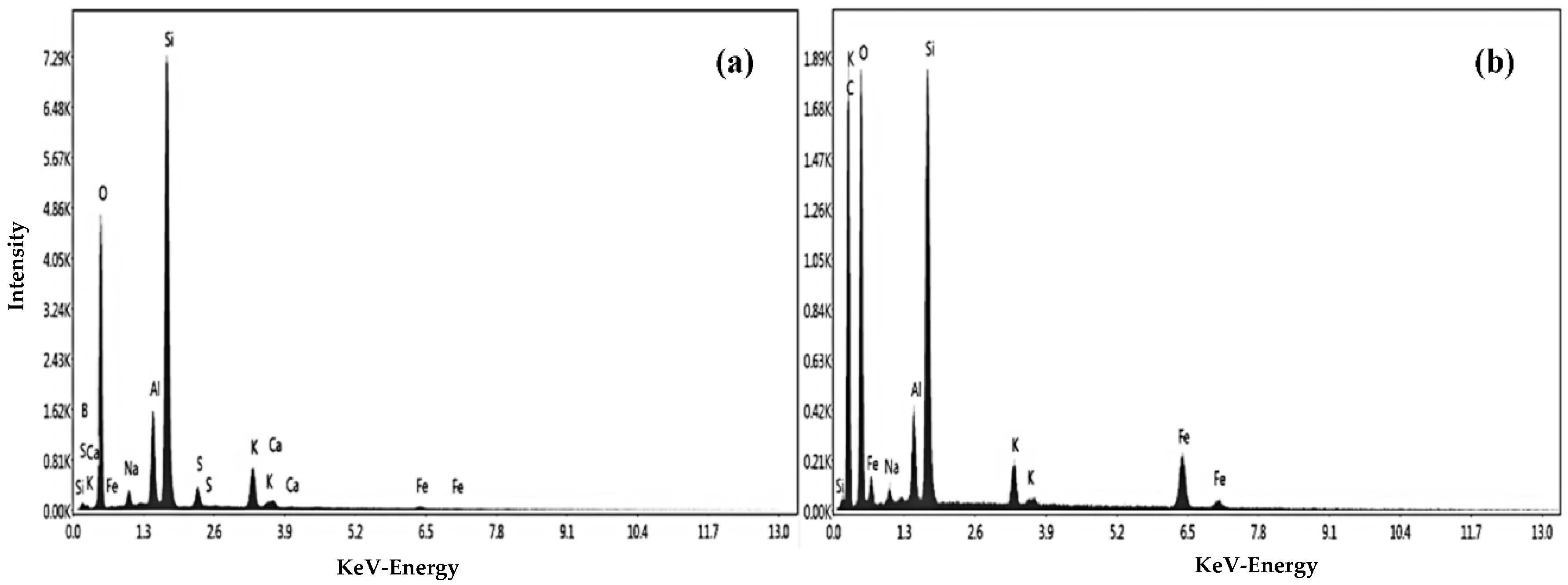
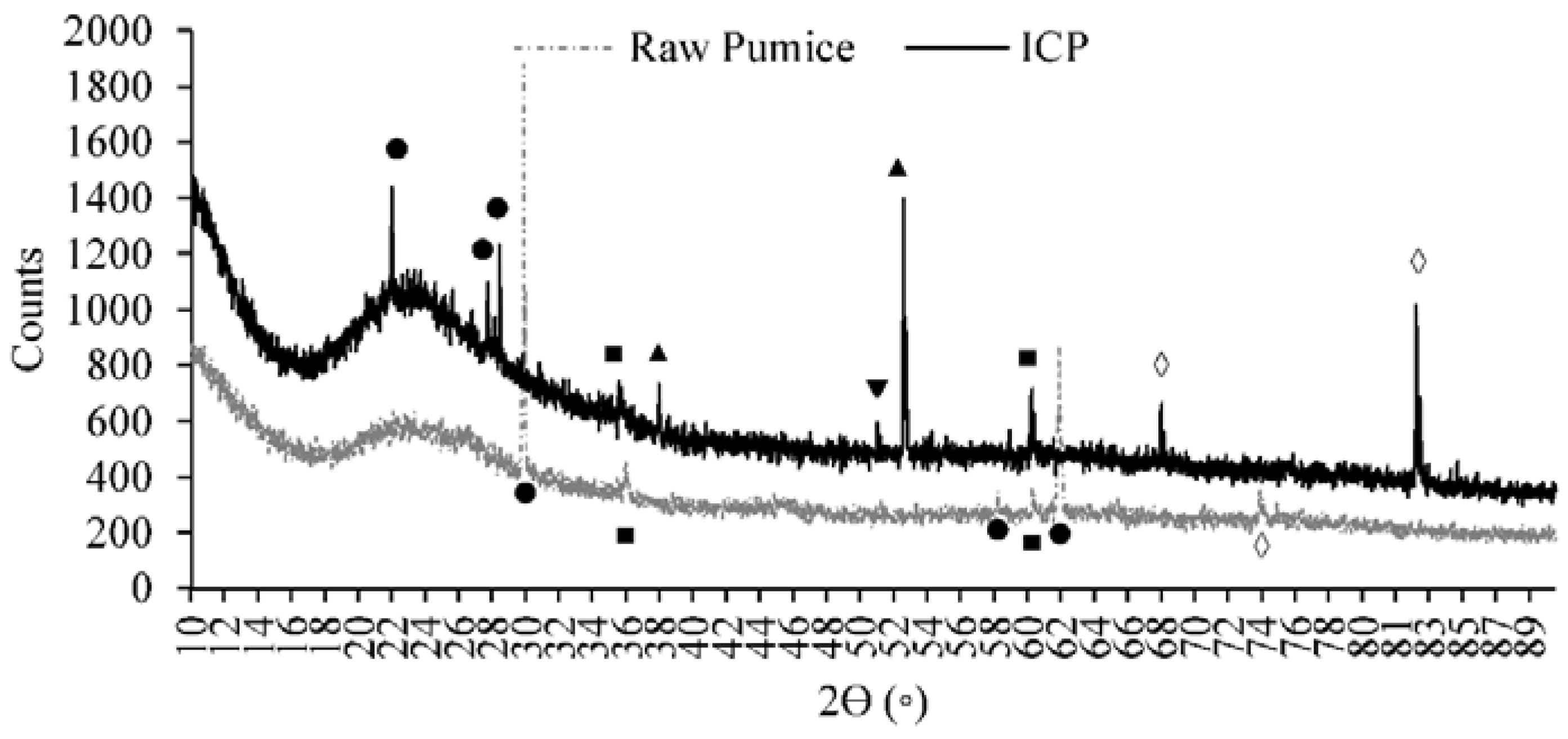

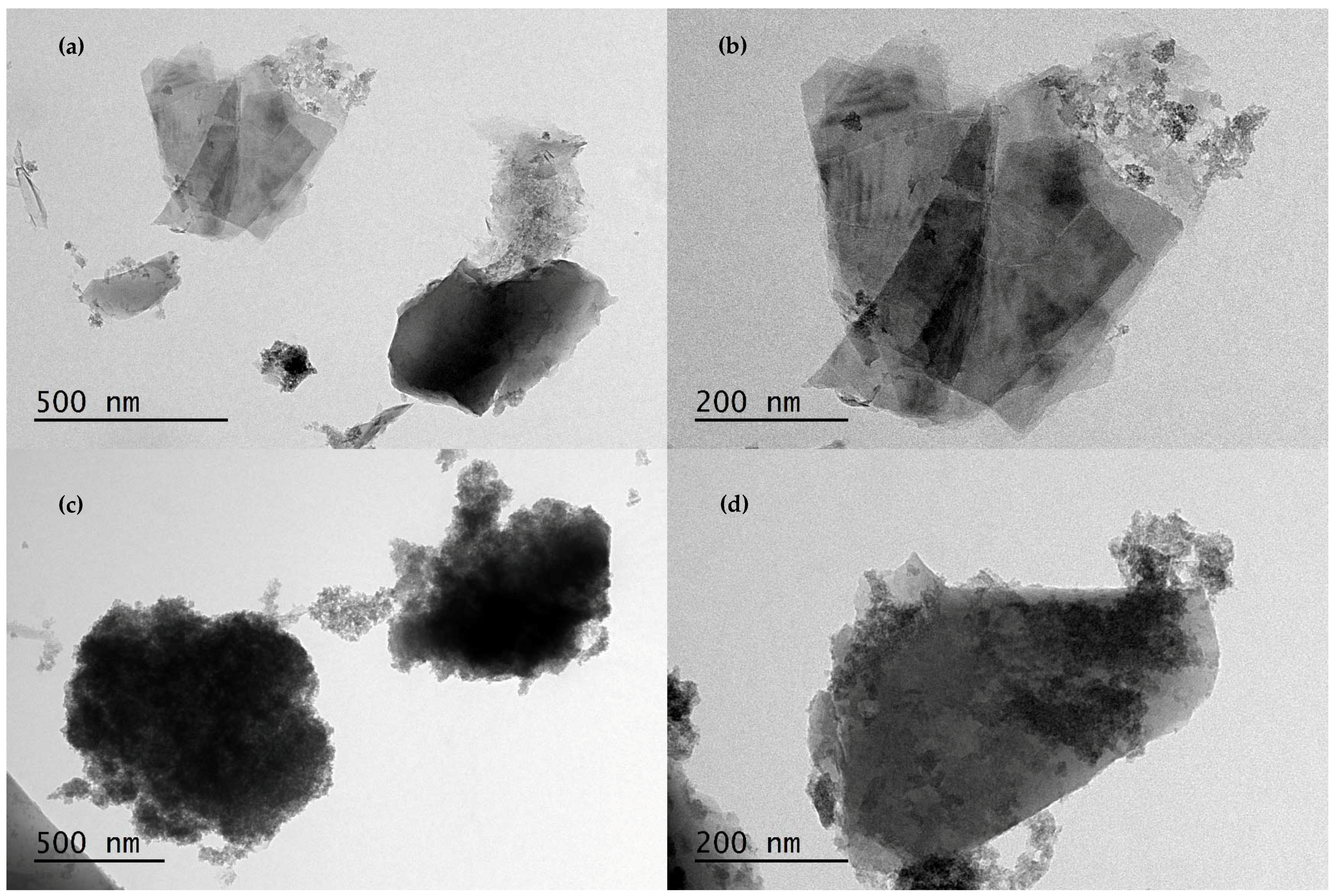




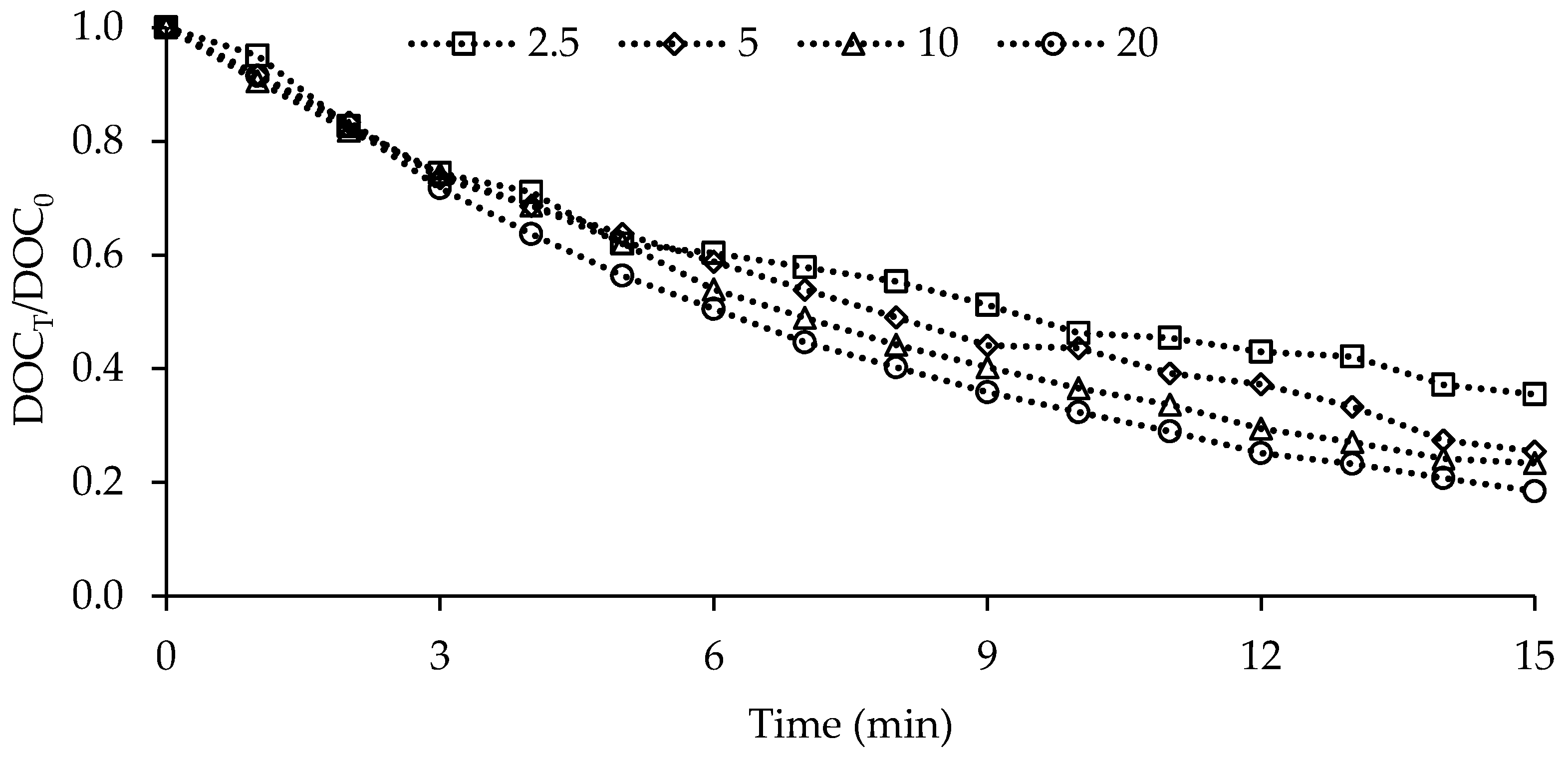

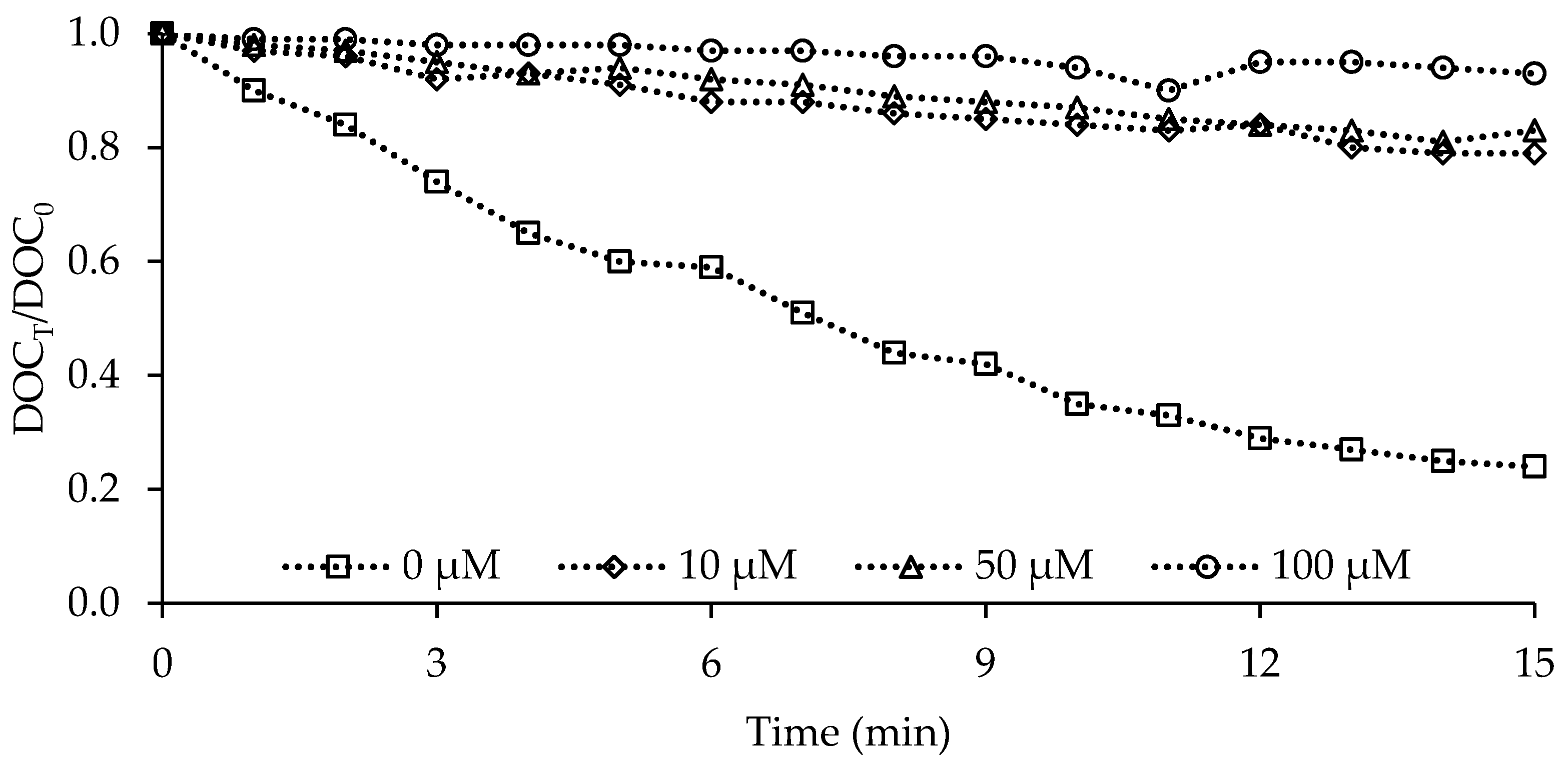
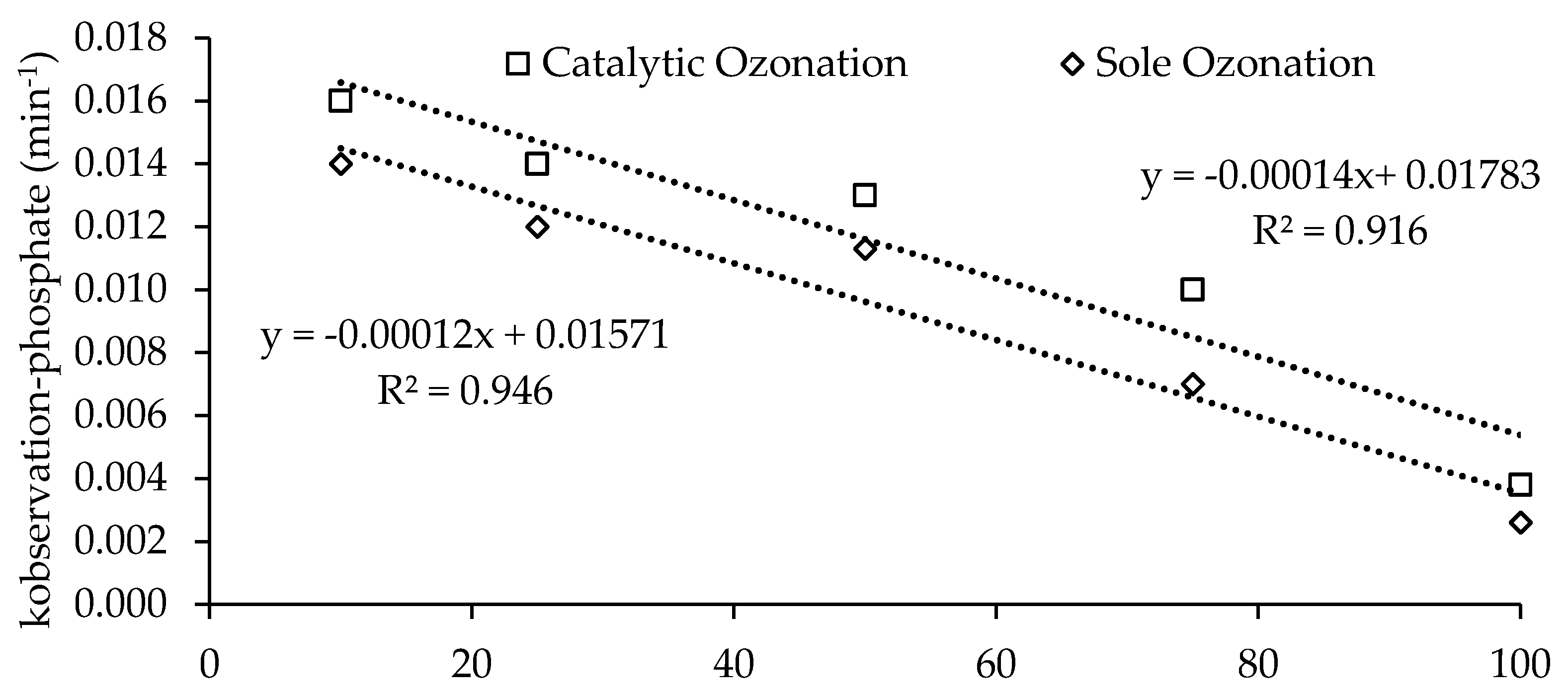
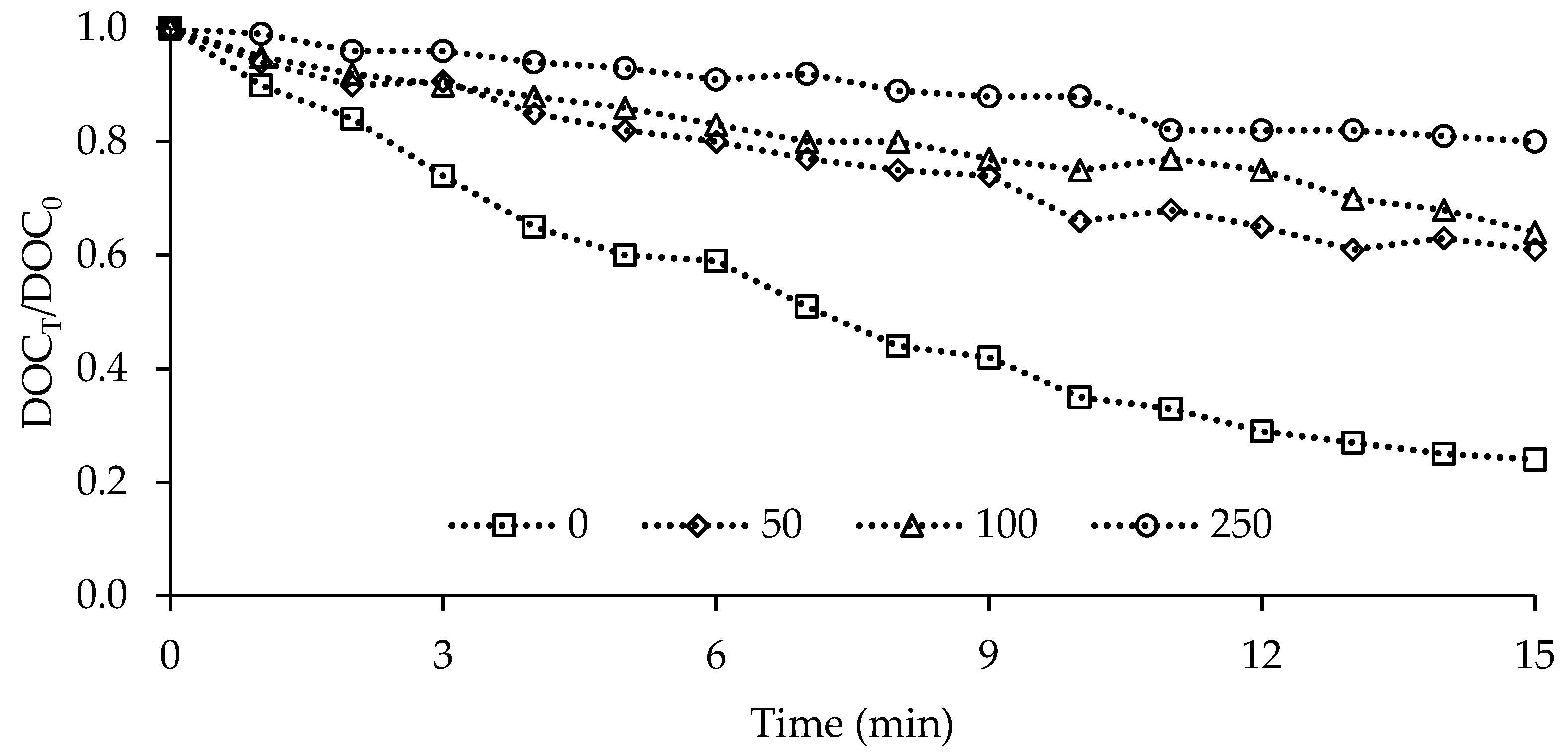
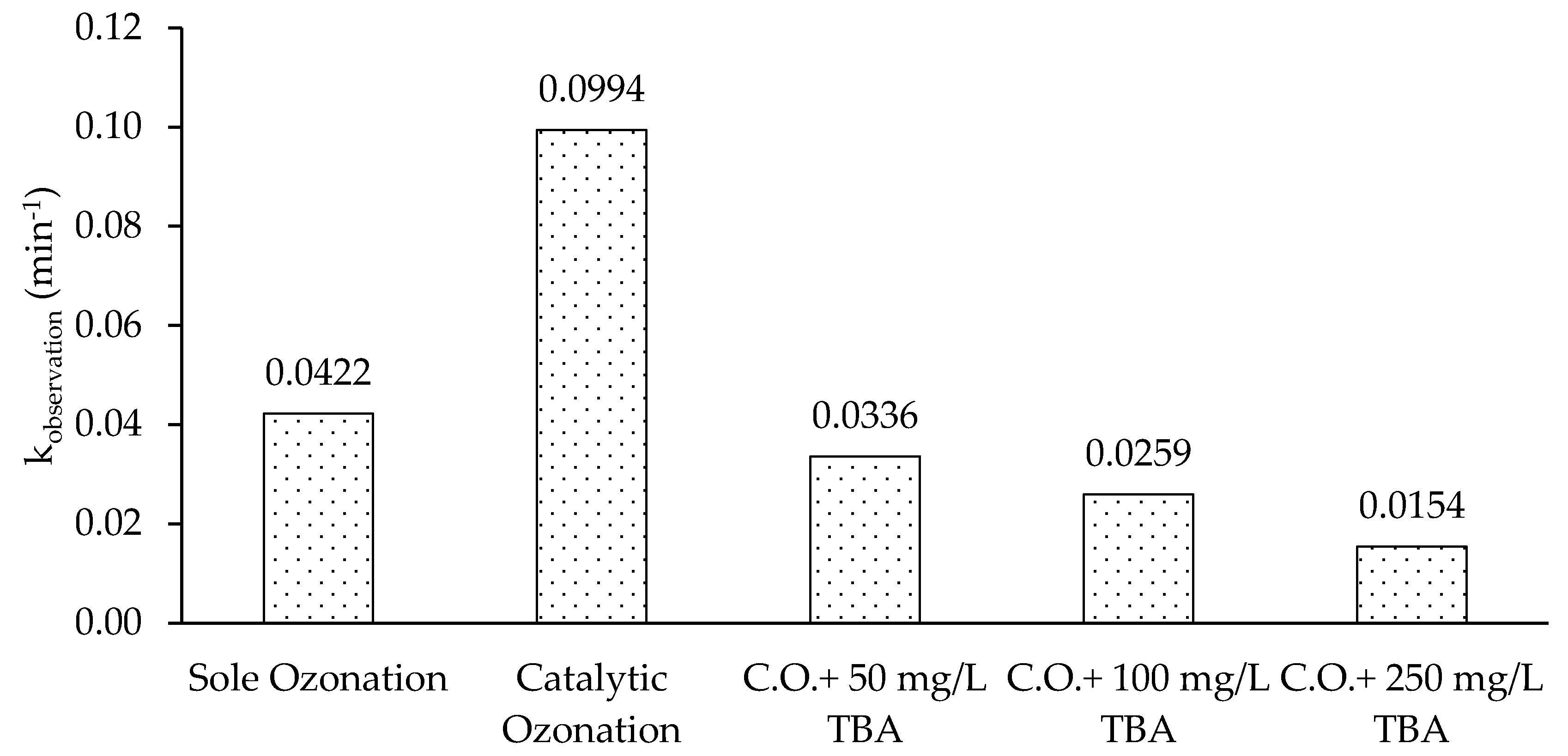
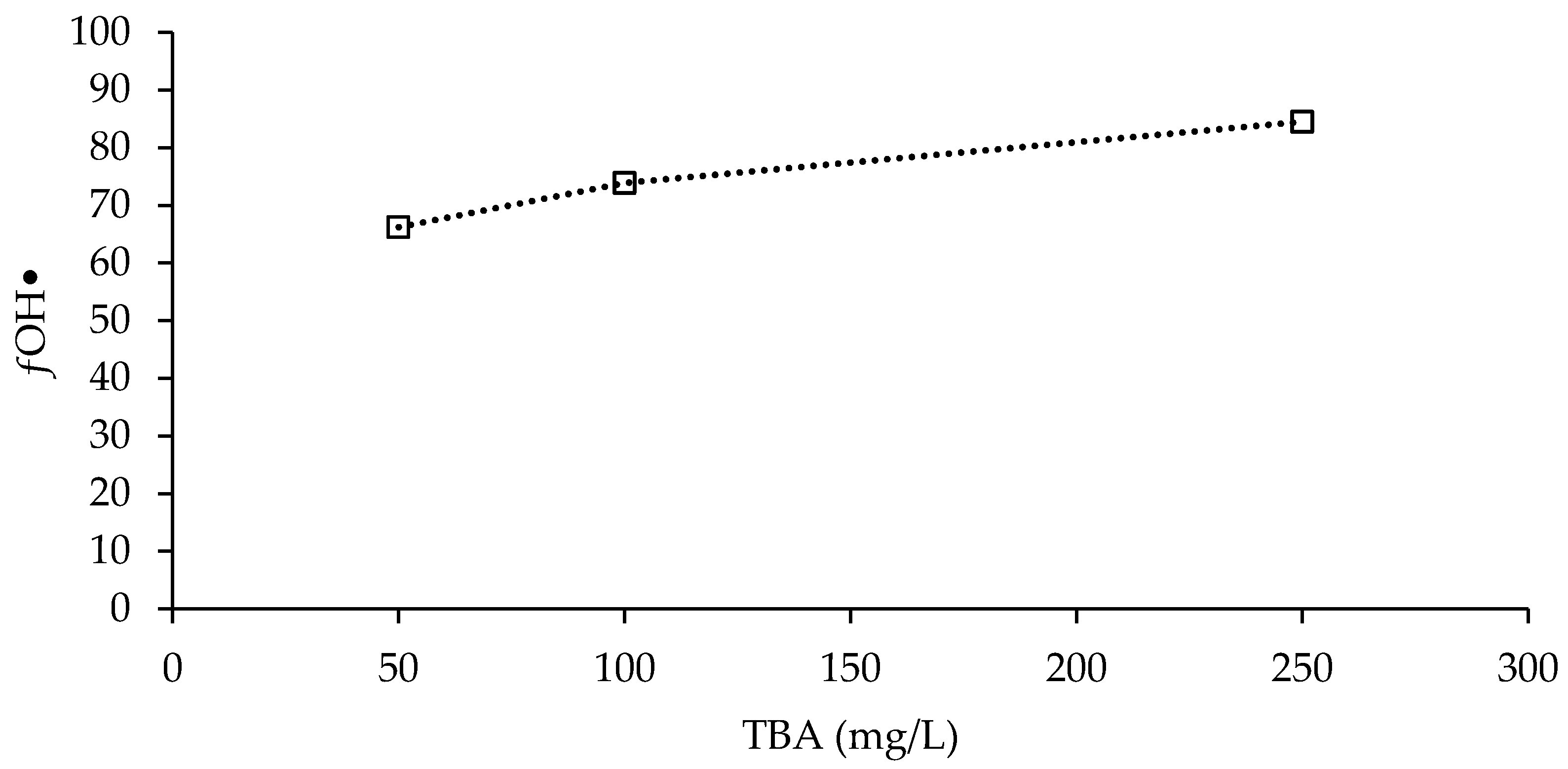
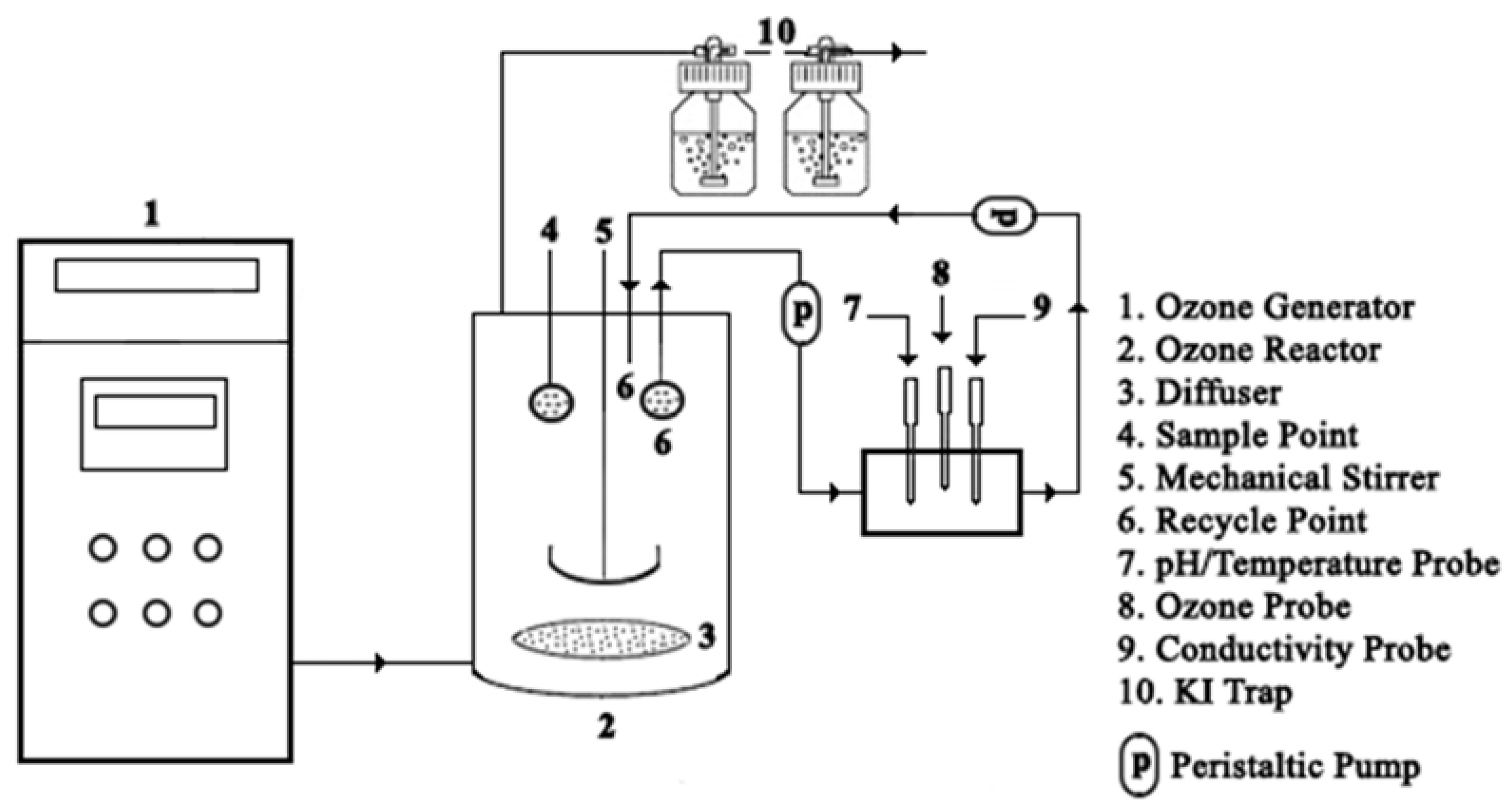
| Parameter | Raw Pumice | ICP |
|---|---|---|
| Average Particle Diameter (d/nm) | 192.70 | 248.10 |
| BET Surface Area (m2/g) | 4.66 | 10.56 |
| Average Adsorption Pore Diameter (nm) | 4.38 | 7.55 |
| Average BJH Adsorption Pore Diameter (nm) | 8.98 | 7.16 |
| Average BJH Desorption Pore Diameter (nm) | 6.12 | 6.09 |
| pHPZC | 6.98 | 7.13 |
| L-H Kinetic Rate Constants | Input Pollutant Concentration, C0 (mg/L) | |||
|---|---|---|---|---|
| 2.5 | 5.0 | 10 | 20 | |
| kobservation (min−1) | 0.0664 | 0.0870 | 0.0994 | 0.1138 |
| R2 | 0.9821 | 0.9926 | 0.9984 | 0.9993 |
| Parameter | Value |
|---|---|
| kL-H (mg L−1 min−1) | 1.7047 |
| kads (L mg−1) | 0.0363 |
| R2 | 0.9900 |
| Reaction Type | ksolution-phosphate (min−1) | kinterface-phosphate (min−1) | ksol.-phosphate/kint.-phosphate |
|---|---|---|---|
| Sole Ozonation | 1.25 × 10−4 | - | - |
| Catalytic Ozonation | 1.22 × 10−4 | 0.09 × 10−4 | 14.33 |
| Reaction Type | ɳadsorption | ɳOH• | ɳozone |
|---|---|---|---|
| Singular ozonation | - | 12.99 | 87.01 |
| Catalytic ozonation | 21.29 | 66.22 | 12.49 |
| Repetition | DOC Removal (%) | Dissolved Iron Concentration In Solution (µg L−1) |
|---|---|---|
| 1 | 76.58 | 2.64 |
| 3 | 75.89 | 8.45 |
| 5 | 77.02 | 11.10 |
| 7 | 76.41 | 12.60 |
| 10 | 75.26 | 9.80 |
© 2018 by the authors. Licensee MDPI, Basel, Switzerland. This article is an open access article distributed under the terms and conditions of the Creative Commons Attribution (CC BY) license (http://creativecommons.org/licenses/by/4.0/).
Share and Cite
Alver, A.; Kılıç, A. Catalytic Ozonation by Iron Coated Pumice for the Degradation of Natural Organic Matters. Catalysts 2018, 8, 219. https://doi.org/10.3390/catal8050219
Alver A, Kılıç A. Catalytic Ozonation by Iron Coated Pumice for the Degradation of Natural Organic Matters. Catalysts. 2018; 8(5):219. https://doi.org/10.3390/catal8050219
Chicago/Turabian StyleAlver, Alper, and Ahmet Kılıç. 2018. "Catalytic Ozonation by Iron Coated Pumice for the Degradation of Natural Organic Matters" Catalysts 8, no. 5: 219. https://doi.org/10.3390/catal8050219





